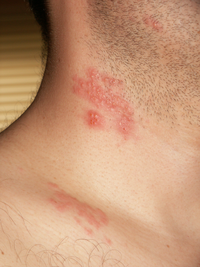
Photo from wikipedia
OBJECTIVE To assess the prevalence of skin lesions and evaluate the clinical and sociodemographic factors associated with their presence in hospitalised patients. METHOD This descriptive, cross-sectional, correlational study was performed… Click to show full abstract
OBJECTIVE To assess the prevalence of skin lesions and evaluate the clinical and sociodemographic factors associated with their presence in hospitalised patients. METHOD This descriptive, cross-sectional, correlational study was performed in inpatient units and intensive care units of a cancer hospital in São Paulo, Brazil, after approval by the Institutional Research Ethics Committee. Data from hospitalised adult patients with cancer were collected during physical examinations and from medical records. A Chi-squared test, univariate analysis, a logistic regression model with results expressed as odds ratio (OR) and 95% confidence intervals (CI), and Classification and Regression Tree (CART) analysis were used to evaluate the data. RESULTS Of 341 patients, 80 had skin lesions, equating to an overall prevalence of 23.5%. The skin lesions included pressure injuries (10%), incontinence-associated dermatitis (6.7%), skin tears (6.5%), malignant wounds (3.8%) and complicated surgical wounds (3.2%). The factors associated with skin lesions in cancer patients were the use of disposable nappies (OR: 4.436) and age (59.1±15.1 years), according to the CART analysis, and the wearing of nappies (OR: 4.466, p<0.001), presence of ecchymosis (OR: 2.532, p<0.001) and infection (OR: 6.449, p=0.040), according to multiple regression analysis. CONCLUSION This study contributed to knowledge about prevalence and associated factors of skin lesions in hospitalised patients with cancer, allowing the implementation of preventive measures.
Journal Title: Journal of wound care
Year Published: 2022
Link to full text (if available)
Share on Social Media: Sign Up to like & get
recommendations!